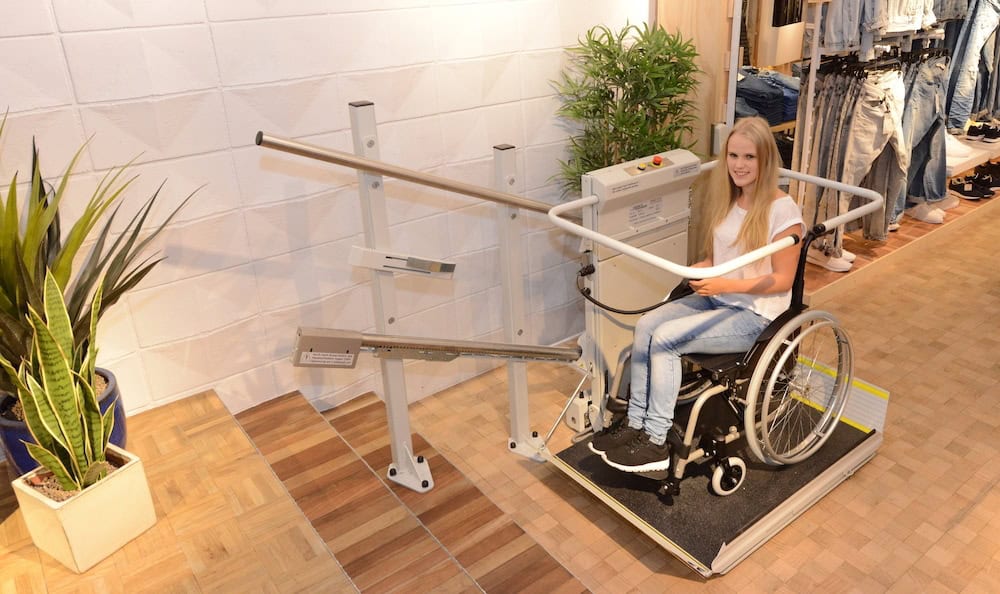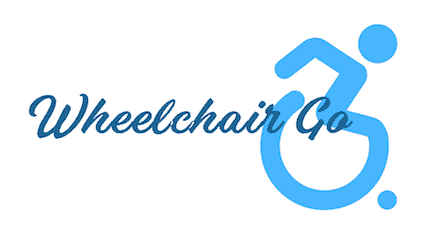Take a moment to imagine a world where every floor in your home is accessible. No more longing glances at the upstairs bedrooms or feeling trapped downstairs. Now picture yourself rolling freely throughout your house, regaining the independence that you cherish.
An in home wheelchair lift can transform your living space into a haven of accessibility, but with so many options available, choosing the right one might feel overwhelming. But now you can stop worrying. This comprehensive guide will be your compass, navigating you through the world of in-home wheelchair lifts and help you to reclaim mobility in your home, floor by floor. We’ll delve into the different types of lifts, explore essential considerations like user needs and home layout, and address common concerns like cost and safety. By the end of this journey, you’ll be empowered to choose the perfect in home wheelchair lift, one that seamlessly integrates with your life and unlocks a world of renewed freedom.

Types of In-Home Wheelchair Lifts: Tailoring Your Mobility Solution
An in home wheelchair lift can empower individuals with mobility limitations to navigate multiple levels within their residence. There are two primary categories of an in home wheelchair lift: platform lifts and stair lifts. Understanding the distinct functionalities and applications of each type will guide you towards selecting the ideal solution for your specific needs and home environment.
Platform lifts function as miniature elevators designed for seamless transportation of wheelchairs and mobility scooters between floors. These lifts offer several advantages:
Platform Lifts: Vertical and Inclined Accessibility
- Spacious Accommodation: Unlike stair lifts, platform lifts provide ample space for most wheelchairs and scooters, ensuring a comfortable and secure ride. This allows for easy maneuvering and eliminates the need for intricate transfers.
- Vertical Platform Lifts (VPLs): VPLs provide a direct vertical ascent, making them ideal for situations with limited space adjacent to the staircase. They can be installed directly beside the stairs or within a dedicated hoistway (a shaft built into the wall) for a more visually integrated aesthetic. VPLs are available in a variety of configurations to accommodate various weight capacities and lifting heights. Modern VPLs prioritize safety with features such as automatic doors, emergency stop buttons, and weight sensors that prevent operation if the platform is overloaded.
- Inclined Platform Lifts (IPLs): IPLs follow the existing incline of your staircase, offering a familiar path for navigating between levels. These lifts are available in both straight and curved configurations to accommodate the specific layout of your stairs. Straight IPLs are typically more cost-effective and simpler to install, making them a popular choice for standard staircases. Curved IPLs provide a more aesthetically pleasing solution for homes with winding staircases. However, their custom track requirements necessitate a higher initial investment and more complex installation process.
Stair Lifts: A Smooth Ride Up the Stairs
Stair lifts are motorized chairs that travel along a track installed on your existing staircase. They provide a comfortable and convenient solution for individuals who can transfer independently from their wheelchair to the stair lift seat. Stair lifts offer several key benefits:
- Straightforward Functionality: Stair lifts operate with a simple joystick or toggle switch, allowing users to navigate up and down the stairs effortlessly. They typically feature a swivel seat that rotates at the top landing, facilitating a smooth transfer back to the user’s wheelchair or desired location.
- Customizable Comfort and Safety: Stair lifts come in various seat styles to accommodate individual needs and preferences. Swivel seats with powered footrests offer enhanced comfort and ease of use, particularly for those with limited mobility in their legs. Safety remains paramount with features like seat belts, emergency stop buttons, and automatic shutoff sensors that prevent operation if the chair encounters an obstruction.
- Stair Lift Options for All Stairways: Stair lifts are not limited to straight staircases. Advanced technology allows for the installation of curved stair lifts that seamlessly follow the unique contours of your existing staircase. While curved stair lifts offer a more aesthetically pleasing solution for winding staircases, their custom track requirements necessitate a higher initial investment and more complex installation process compared to straight stair lifts. It’s important to consult with a qualified professional to assess your specific staircase and determine the optimal lift configuration for your needs.
Things to Consider When Choosing an In Home Wheelchair Lift: Finding Your Perfect Fit

Selecting the ideal in home wheelchair lift requires careful consideration of several factors. By thoughtfully evaluating your specific needs and home environment, you can ensure a seamless integration of the lift into your daily life. Here’s a breakdown of key factors to ponder:
Needs Assessment: Understanding Your Requirements
The foundation for choosing the right lift lies in a thorough understanding of your individual needs. Here are some crucial aspects to consider:
- User Weight and Wheelchair Dimensions: Wheelchair lifts have weight capacity limitations. It’s vital to choose a lift that can safely accommodate the combined weight of the user, wheelchair, and any additional cargo (e.g., oxygen tanks). Measure the width, length, and height of your wheelchair to ensure it fits comfortably on the lift platform or seat.
- Transfer Capabilities: Consider your ability to transfer independently from your wheelchair to the lift seat. Platform lifts offer more space for maneuvering during transfers, while stair lifts may require a greater degree of upper body strength or assistance for transferring.
Home Layout: Optimizing for Accessibility
The layout of your home plays a critical role in determining the most suitable lift type and its placement. Here’s what to keep in mind:
- Staircase Type and Available Space: Identify the type of staircase (straight, curved) and measure the available space alongside it. Platform lifts typically require more space next to the stairs compared to stair lifts. Curved staircases may necessitate a custom curved track for a stair lift, impacting the installation complexity and cost.
- Doorway Clearances: Ensure the doorways on both floors where the lift will be used have sufficient clearance to accommodate the wheelchair and the lift platform or seat when fully extended. Minor doorway modifications might be necessary to ensure smooth passage.
Budget: Balancing Functionality and Cost
The cost of an in home wheelchair lift varies depending on several factors, including the type of lift, features, installation complexity, and brand. Here’s how to approach budgeting for your lift:
- Lift Type and Features: Platform lifts generally cost more than stair lifts due to their larger size and additional functionalities. Consider the essential features you require and prioritize them within your budget. Optional features like powered gates or folding platforms can add to the overall cost.
- Installation Charges: The complexity of installation can significantly impact the overall cost. Straight stair lifts and platform lifts with minimal modifications typically involve simpler installations compared to curved stair lifts or VPLs requiring hoistway construction. Factor in potential electrical work or structural reinforcement needs during the budgeting process.
- Ongoing Maintenance: Plan for routine maintenance costs associated with your chosen lift. Most manufacturers recommend annual inspections and periodic servicing to ensure optimal performance and safety.
Safety Features: Peace of Mind for Everyday Use
Safety should be paramount when choosing a wheelchair lift. Look for these essential safety features:
- Weight Capacity Limits: Ensure the lift’s capacity comfortably exceeds the combined weight of the user, wheelchair, and any additional cargo.
- Emergency Stop Buttons: Readily accessible emergency stop buttons on both the lift and the control panel allow for immediate stoppage in case of an issue.
- Automatic Shutoff Sensors: These sensors prevent the lift from operating if it encounters an obstruction on the platform or track, safeguarding users and preventing damage.

Additional Considerations: Enhancing Your Experience
Beyond the core functionalities, consider these additional factors to optimize your experience with your in-home wheelchair lift:
- Ease of Use: Choose a lift with user-friendly controls that are easy to operate for both the user and any potential caregivers.
- Power Source: Lifts can be powered by electricity or batteries. Battery-powered lifts offer more flexibility in placement but require regular charging. Electric lifts provide a continuous power source but necessitate a nearby electrical outlet for installation.
- Noise Level: Consider the noise level generated by the lift, particularly if it will be installed near bedrooms or living areas. Modern lifts are becoming progressively quieter, but noise level variations exist between different models.
- Aesthetics: Modern lifts come in various finishes and colors to complement your home’s décor.
People Also Ask: Some Common Questions About In Home Wheelchair Lifts
In-home wheelchair lifts empower individuals with regained mobility and independence, but navigating the selection process can raise several questions. This section addresses some of the more frequently asked questions to provide you with the information you need to make an informed decision.
Are in home wheelchair lifts covered by insurance?
Coverage for an in home wheelchair lift can vary depending on your insurance provider and specific policy details. Here’s a breakdown to consider:
- Medicare and Medicaid: These programs may offer partial coverage for wheelchair lifts deemed medically necessary to access your primary residence. Be sure to consult with your doctor and insurance provider to understand your specific plan’s coverage criteria and application process.
- Private Insurance: Some private insurance plans may offer coverage for wheelchair lifts, particularly if they are deemed essential for maintaining your health and safety at home. Contact your insurance provider to inquire about coverage details, including any limitations or exclusions that might apply.
- Home Improvement Grants and Loans: Government agencies and non-profit organizations may offer financial assistance programs to help individuals with disabilities modify their homes to improve accessibility. Research local resources and grant opportunities that might help offset the cost of an in home wheelchair lift installation.
It’s crucial to proactively research your insurance coverage and explore potential financial assistance programs before making a final decision on an in home wheelchair lift.
How much does an in-home wheelchair lift cost?
The cost of an in home wheelchair lift can vary depending on several factors, including:
- Lift Type: Platform lifts generally have a higher initial cost compared to stair lifts. Factors like weight capacity, platform size, and additional features (powered gates, swivel seats) can further influence the price.
- Staircase Configuration: Straight staircases are typically more affordable to install lifts on compared to curved staircases. Curved stair lifts necessitate custom track configurations, increasing the complexity and cost of installation.
- Installation Requirements: Standard lift installations for straight stairs or platform lifts with minimal modifications might be more cost-effective compared to complex installations involving hoistway construction for VPLs or custom curved tracks for stair lifts.
Here’s a general cost range to provide a starting point:
- Stair Lifts: $3,000 – $10,000 (straight) $5,000 – $15,000+ (curved)
- Platform Lifts: $7,000 – $20,000+ (depending on features and weight capacity)
It’s advisable to obtain quotes from reputable wheelchair lift dealers in your area to get a more accurate estimate based on your specific needs and home configuration.
Can I install an in home wheelchair lift myself?
While some technical knowledge might allow for basic DIY projects, in home wheelchair lift installations are highly recommended to be completed by qualified professionals. Here’s why:
- Safety Concerns: Improper installation can compromise the safety and functionality of the lift, potentially leading to serious injuries. Professionals ensure the lift is securely anchored and meets all safety codes.
- Warranty Considerations: Most wheelchair lift manufacturers require a certified professional to perform the installation to uphold the product warranty. DIY installation might void the warranty, leaving you responsible for any future repairs or malfunctions.
- Expertise and Efficiency: Qualified installers possess the expertise and experience to efficiently install the lift according to the manufacturer’s specifications. They can also address any unforeseen challenges during the installation process.
For optimal safety, functionality, and warranty protection, entrusting the installation to a qualified professional is the most prudent course of action.
How do I maintain my in home wheelchair lift?
Regular maintenance is essential to ensure the safe and reliable operation of your in-home wheelchair lift. Here’s a general overview of maintenance practices:
- Manufacturer’s Recommendations: Refer to the owner’s manual for your specific lift model. It will outline recommended maintenance procedures, lubrication schedules, and any troubleshooting tips.
- Annual Professional Inspection: Schedule an annual inspection by a qualified wheelchair lift technician. They will perform a comprehensive inspection, identify any potential issues, and ensure the lift operates within safety specifications.
- Daily/Weekly User Checks: Develop a routine for the user to perform basic checks, such as inspecting for loose parts, debris on the track (for stair lifts), and ensuring the lift platform or seat operates smoothly.
Following these maintenance practices will extend the lifespan of your wheelchair lift and promote safe and reliable operation for years to come.
Conclusion: Reclaim Your Independence, One Floor at a Time
In home wheelchair lifts have the power to transform your living space into a haven of accessibility. Imagine navigating every floor of your home with newfound ease, regaining the independence to access all areas and participate fully in daily activities. This comprehensive guide has equipped you with the knowledge to confidently navigate the world of in home wheelchair lifts. We’ve explored the different lift types (platform and stair lifts), delved into crucial considerations (needs assessment, home layout, budget, safety), and addressed common concerns (insurance coverage, cost, installation, maintenance).
Remember, the ideal in home wheelchair lift seamlessly integrates with your life, not the other way around. By carefully considering your specific needs and home environment, you can select a lift that empowers you to move freely and confidently throughout your residence. Don’t hesitate to take the next step towards regaining your independence. Research reputable wheelchair lift dealers in your area, schedule consultations to discuss your options, and unlock a world of renewed possibilities within your own home. Remember, a little planning today can pave the way for a lifetime of independence tomorrow.
